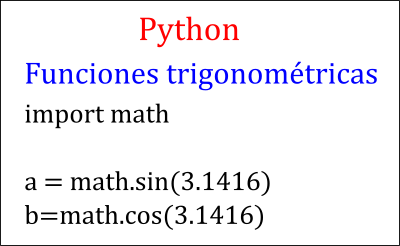Python Sin and Cos in Degrees
The round function will round the result returned by radians function to single precision. Mathcos function returns the cosine of value passed as argument.

How To Use Sin And Cos In Python Code Example
The return value x in your example is a dimensionless number.

. X This must be a numeric value. Python number method cos returns the cosine of x radians. 049999999999999994 The value of cosine of pi6 is.
The input to the sin function must be a numeric value. X npsin nppi2 printx Try it Yourself. Sin x Python.
On your calculator you have calculated the cos of 1 degree. The sine of 30 in degree 049999999999999994 The sine of 45 in degree 07071067811865475 The sine of 60 in degree 08660254037844386. Radians0 mathradians0 sin0 mathsinRadians0 sin0Rounded.
COSINE printnTrigonometric COSINE cosine cosine_degrees mathcosmathradians60 printcosine of 60 degrees is roundcosine_degrees 2 or Fractioncosine_degreeslimit_denominator prints cosine of 60 degrees is 05 or 12. NumPy provides the ufuncs sin cos and tan that take values in radians and produce the corresponding sin cos and tan values. Is math sin radians or degrees.
Radians90 mathradians90 cos90 mathcosRadians90 cos90Rounded roundcos902 mathcosradians. Array of angles given in degrees print npcos nparray 0 30 45 60 90 nppi 180 print tangent. We can calculate trigonometric ratios using functions like numpysin numpycos and numpytan to find the sine cosine and tangent values respectively.
For example import math angle1 mathradians90 angle2 mathradians60 printmathcosangle1 printmathcosangle2. Output Cosine value of angle 180 in degree -05984600690578581. Npsinnpdeg2raddegrees cosd lambda degrees.
Npcosarr1 npcosarr2 npcosarr3 npcosarr6 The Python numpy tan function returns the tangent value of a given array. Printcos 0formatcos0Rounded printcos 30formatcos30Rounded printcos 45formatcos45Rounded. Array of angles given in degrees print npsin nparray 0 30 45 60 90 nppi 180 print cosine.
The command to obtain the sine cosine and tangent of an Angle of 573 degrees which in radians is approximately 1 is the following. Find sine value of PI2. To find the sine of degrees it must first be converted into radians.
If yes youre in the correct post. Value to be passed to cos Returns. Cosine value of the angle in radians.
You can define the following symbols to work in degrees. The mathsin method returns the sine of a number. In your Python example you have calculated the cos of 1 radian which is equivalent to 57296 degrees.
Following is the syntax for cos method. The return value will be a numeric value between -1 and 1. To get cosine value of the angle in radians need to multiply angle with nppi180.
Because sin is a static method of Math you always use it as Math. The first pair is xy. The value of sine of pi6 is.
X nparange04nppi01 startstopstep y npsinx z npcosx To plot both sine and cosine on the same set of axies we need to include two pair of xy values in our pltplot arguments. Printing cosine values for common angles. The value passed in this function should be in radians.
Sin method returns a numeric value between -1 and 1 which represents the sine of the angle given in radians. Note that these functions expect angles in radians. For example import numpy as np printnpcos05 Output.
The example below uses three functions together. Import math amathsin 1 bmathcos 1 cmathtan 1 print a Imprime. Import numpy as np.
Import numpy as np print sine. Npsinarr1 npsinarr2 npsinarr3 npsinarr6 The Python numpy cos function returns the cosine value of a given array. The value passed in this function should be in radians.
This method returns a numeric. Python numpy sin function returns the sine value of a given array. Tan - This function returns the tangent of value passed as argument.
Do you want to know the details about sin and cos in python. How do you find sin 30 in Python. In Python math module contains a number of mathematical operations which can be performed with ease using the module.
Sin and cos in python import math angle_in_degrees 45 angle_in_radians mathradiansangle_in_degrees sin_of_angle mathsinangle_in_radians cos_of_angle mathcosangle_in_radians. Npcosnpdeg2raddegrees printsind90 Output 10. Below is the Python syntax to find the sine of a number.
Sind lambda degrees. Array of angles given in degrees print nptan nparray 0 30 45 60 90 nppi 180. On your calculator this angle is in degress in Python this angle must be given in radians.
Using sin and cos in Python. Cos_180 npcos180 nppi180printCosine value of angle 180 in radians cos_180. Rounding the result example.
X 0 0 radians sinx 00 cosx 10 tanx 00 x 45 025 π radians sinx 0707 cosx 0707 tanx 10 x 90 05 π radians sinx 10 cosx 00 x 135 075 π radians sinx 0707 cosx -0707 tanx -10 x 180 10 π radians sinx 00 cosx -10 tanx -00 x 225 125 π radians sinx -0707 cosx -0707 tanx 10 x. Sin θ value for zero degrees. Cos 90 value for zero degrees.
Returns the cosine of value passed as. Cosx Note This function is not accessible directly so we need to import math module and then we need to call this function using math static object. You can import that library and use these functions.
0841 print b Imprime. In the math library the trigonometric functions are in radians and not degrees. Pythonの数学関数の標準モジュールmathを使うと三角関数sin cos tanおよび逆三角関数arcsin arccos arctanの計算ができる92.
Below we have a simple code example for the 3 trigonometric functions defined above import math printmathsinmathpi3 pi3 radians is converted to 60 degrees printmathtanmathpi3 printmathcosmathpi6 Output. Sin radians and round. Python comes with an amazing standard math library that provides all trigonometric functions like sin cos etc.
Math 数学関数 三角関数 Python 364 ドキュメント ここでは以下の内容についてサンプルコードとともに説明する円周率パイ. 08775825618903728 It is worth noting that angles by default are accepted in radians and not in degrees in the above example. To find the sine of a number in radians we use the math sin function.
Code example for sin cos and tan.


Comments
Post a Comment